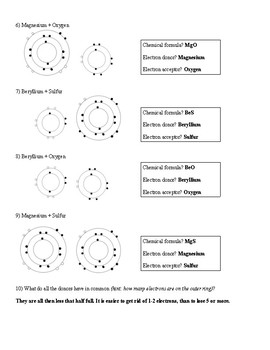

What we need is a second Na atom to donate a second electron to the O atom: The O atom still does not have an octet of electrons. What about when an Na atom interacts with an O atom? The O atom needs two electrons to complete its valence octet, but the Na atom supplies only one electron: Remember, in the final formula for the ionic compound, we do not write the charges on the ions. The two ions each have octets as their valence shell, and the two oppositely charged particles attract, making an ionic bond: A similar process occurs between Mg atoms and O atoms, except in this case two electrons are transferred: In electron transfer, the number of electrons lost must equal the number of electrons gained. Ionic bonds are caused by electrons transferring from one atom to another. The attraction between oppositely charged ions is called an ionic bond, and it is one of the main types of chemical bonds in chemistry. Where we have written the final formula (the formula for sodium chloride) as per the convention for ionic compounds, without listing the charges explicitly. This is what happens to the Na + and Cl − ions: From basic physics, we know that opposite charges attract. Resulting in two ions - the Na + ion and the Cl − ion:īoth species now have complete octets, and the electron shells are energetically stable. An electron transfers from the Na atom to the Cl atom: The two atoms have these Lewis electron dot diagrams and electron configurations:įor the Na atom to obtain an octet, it must lose an electron for the Cl atom to gain an octet, it must gain an electron. Now consider an Na atom in the presence of a Cl atom. The octet rule is a result of trends in energies and is useful in explaining why atoms form the ions that they do. It turns out that the Na + ion has a complete octet in its new valence shell, the n = 2 shell, which satisfies the octet rule. However, that requires much more energy than is normally available in chemical reactions, so sodium stops at a 1+ charge after losing a single electron. We could remove another electron by adding even more energy to the ion, to make the Na 2+ ion. It is rather reactive, however, and does not require a lot of energy to remove that electron to make the Na + ion.

Consider sodium: in its elemental form, it has one valence electron and is stable.

It is not impossible to violate the octet rule. When atoms form compounds, the octet rule is not always satisfied for all atoms at all times, but it is a very good rule of thumb for understanding the kinds of bonding arrangements that atoms can make. The trend that atoms like to have eight electrons in their valence shell is called the octet rule. For whatever reason, having eight electrons in a valence shell is a particularly energetically stable arrangement of electrons. The lower shell, now the valence shell, has eight electrons in it, so the atom becomes positively charged. Either atoms gain enough electrons to have eight electrons in the valence shell and become the appropriately charged anion, or they lose the electrons in their original valence shell. The astute reader may have noticed something: Many of the ions that form have eight electrons in their valence shell. In the section “Lewis Electron Dot Diagrams”, we saw how ions are formed by losing electrons to make cations or by gaining electrons to form anions.
ION BONDING PRACTICE FULL
negative Elements in Group 17(the halogens) are the _ reactive nonmetals most Elements in Group 1 lose one electron to form ions with a(n) _ charge positive An element is stable when it has a full _ shell. True Complete each statement by matching the word with the statementĮ. False ionic bond T or F? Orderly crystal shapes, high melting points, and electrical conductivity when dissolved in water are properties of ionic compounds. False becomes a negative ion when gaining an electron T or F? the attraction between a positive ion and a negative ion results in a covalent bond. False they are the farthest T or F? when an atom gains an electron it become a positive ion. In what form can an ionic compound conduct electricity? when dissolved in water What term means that metals can be hammered or pound into thin sheets, as in aluminum foil or beaten into complex shapes? malleable Which term means that metals can be pulled into thin strands or wires? ductile T or F? The valance electrons are those electrons closets to the nucleus. Which of the following is a characteristic property of ionic compounds? They form hard, brittle crystals with characteristic shapes.


 0 kommentar(er)
0 kommentar(er)
